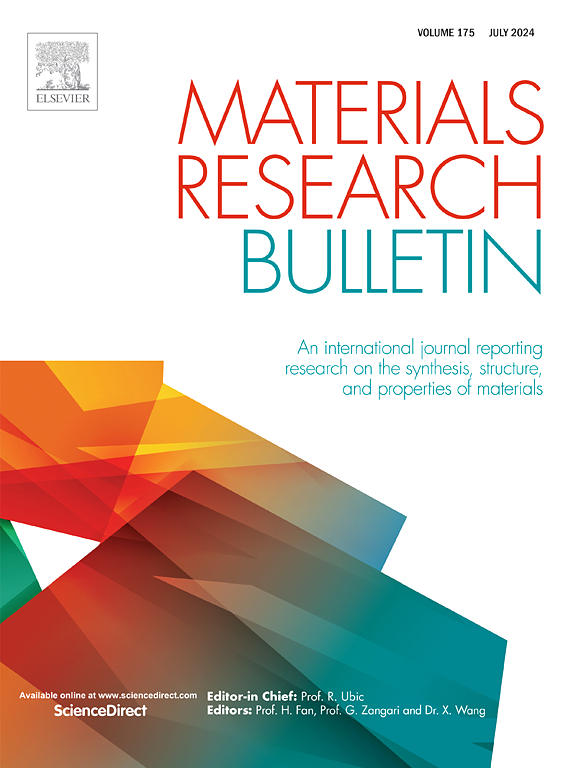Zn2+-decorated porous g-C3N4 with nitrogen vacancies: Synthesis, enhanced photocatalytic performance and mechanism in degrading organic contaminants
IF 5.3
3区 材料科学
Q2 MATERIALS SCIENCE, MULTIDISCIPLINARY
引用次数: 0
Abstract
Photocatalytic degradation is an effective and challenging strategy in purifying wastewaters containing organic pollutants. Thus, developing a suitable photocatalyst and clarifying the degradation mechanism are extremely worthwhile. In this work, Zn2+-decorated porous g-C3N4 with nitrogen vacancies (g-C3N4-δ) is prepared with the facile sonication-calcination method. Benefitting from the modified geometric structure and electronic properties, compared with g-C3N4-δ, the resulting composites deliver reduced micropore percentage, enhanced separation and migration of photogenerated carriers, narrowed band gap, and improved reducing capacity of photoinduced electrons, favoring the photocatalytic reaction. Particularly, Zn2+(2)-g-C3N4-δ (10 mg) displays the highest photocatalytic activity toward eliminating tetracycline (TC, 10 mg L-1, 50 mL), and the degradation efficiency (63.9%) within 30 min is 3.4 times that of g-C3N4-δ (18.9%) irradiated by visible light. Moreover, the optimal composite demonstrates satisfactory recyclability and excellent universality. This study suggests a novel way to construct g-C3N4-based photocatalysts for efficiently degrading organic contaminants in water.
含氮空位的Zn2+装饰多孔g-C3N4:合成、增强的光催化性能和降解有机污染物的机理
在净化含有有机污染物的废水方面,光催化降解是一种既有效又具有挑战性的策略。因此,开发一种合适的光催化剂并阐明其降解机理是非常有价值的。本研究采用简便的超声煅烧法制备了具有氮空位的 Zn2+ 装饰多孔 g-C3N4(g-CN4-δ)。与 g-C3N4-δ 相比,由于改变了几何结构和电子特性,所制备的复合材料减少了微孔比例,增强了光生载流子的分离和迁移,缩小了带隙,提高了光诱导电子的还原能力,有利于光催化反应。其中,Zn2+(2)-g-C3N4-δ(10 毫克)对消除四环素(TC,10 毫克/升,50 毫升)的光催化活性最高,30 分钟内的降解效率(63.9%)是用可见光照射 g-C3N4-δ (18.9%)的 3.4 倍。此外,这种最佳复合材料还具有令人满意的可回收性和出色的通用性。这项研究为构建基于 g-C3N4 的光催化剂,高效降解水中的有机污染物提供了一种新方法。
本文章由计算机程序翻译,如有差异,请以英文原文为准。
求助全文
约1分钟内获得全文
求助全文
来源期刊

Materials Research Bulletin
工程技术-材料科学:综合
CiteScore
9.80
自引率
5.60%
发文量
372
审稿时长
42 days
期刊介绍:
Materials Research Bulletin is an international journal reporting high-impact research on processing-structure-property relationships in functional materials and nanomaterials with interesting electronic, magnetic, optical, thermal, mechanical or catalytic properties. Papers purely on thermodynamics or theoretical calculations (e.g., density functional theory) do not fall within the scope of the journal unless they also demonstrate a clear link to physical properties. Topics covered include functional materials (e.g., dielectrics, pyroelectrics, piezoelectrics, ferroelectrics, relaxors, thermoelectrics, etc.); electrochemistry and solid-state ionics (e.g., photovoltaics, batteries, sensors, and fuel cells); nanomaterials, graphene, and nanocomposites; luminescence and photocatalysis; crystal-structure and defect-structure analysis; novel electronics; non-crystalline solids; flexible electronics; protein-material interactions; and polymeric ion-exchange membranes.
 求助内容:
求助内容: 应助结果提醒方式:
应助结果提醒方式:


